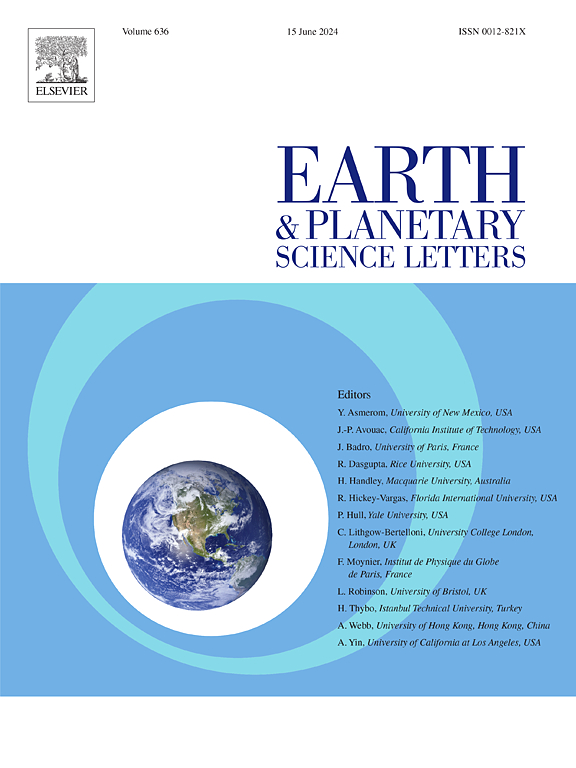Lower mantle water distribution from ab initio proton diffusivity in bridgmanite
IF 4.8
1区 地球科学
Q1 GEOCHEMISTRY & GEOPHYSICS
引用次数: 0
Abstract
Proton self diffusion coefficients for bridgmanite at lower mantle conditions are calculated from ab initio molecular dynamics simulations. We find that the proton self diffusion coefficient, is nearly constant ∼ 10−8 m2 s−1 along the lower mantle geotherm but increases by nearly one order of magnitude from ∼10−10 m2 s−1 to ∼ 10−9 m2 s−1 along a cold slab geotherm to about 1800 km depth. These rates imply that the proton diffusion length scale is less than 10 km in lower mantle peridotite in the 150-200 million years timescale for slab material to sink through the lower mantle. Cold wet slabs probably lose less than one percent of their total water content to the ambient mantle on their journey through the lower mantle, indicating that recycled water is far from homogeneously distributed since slab delivery is highly heterogeneous. We estimate that 0.1 to 0.3 ocean masses (<100 ppm wt%) of recycled water may be currently stored in slab remnant materials within the lower mantle. This water is likely not entrained by plumes but is instead captured by background mantle flow before returning to the mid-ocean ridges. By contrast, deep-rooted mantle plumes may entrain materials containing primordial-like water from the lowermost mantle or the core, and preserve these anomalies in fairly small-scale heterogeneities. Over the age of the Earth, the proton diffusion length scale is a few tens of km, which places constraints on the size of possible primordial water reservoirs isolated from convective mixing, and indicates little flux of water across the core-mantle boundary.
从桥粒石中的质子扩散性得出下地幔水的分布情况
通过ab initio分子动力学模拟,计算了桥芒石在下地幔条件下的质子自扩散系数。我们发现,质子自扩散系数 Dself 沿下地幔地温几乎恒定为 ∼ 10-8 m2 s-1,但沿冷板块地温至约 1800 千米深度则增加了近一个数量级,从 ∼10-10 m2 s-1 增加到 ∼ 10-9 m2 s-1。这些速率意味着,在板块物质通过下地幔下沉的1.5亿-2亿年时间尺度内,质子在下地幔橄榄岩中的扩散长度尺度小于10千米。冷湿板坯在穿过下地幔的过程中,可能损失不到其总含水量的百分之一到环境地幔中,这表明由于板坯的输送是高度异质的,所以回收的水远远不是均匀分布的。我们估计,目前可能有 0.1 到 0.3 个大洋质量(100 ppm wt%)的循环水储存在下地幔内的板块残余物质中。这些水很可能没有被羽流夹带,而是在返回大洋中脊之前被背景地幔流捕获。相比之下,根深蒂固的地幔羽流可能会夹带来自最底层地幔或地核的含有类似原始水的物质,并将这些异常保留在相当小尺度的异质中。在地球年龄段,质子扩散的长度尺度为几十公里,这就限制了可能与对流混合隔绝的原始水储层的大小,并表明穿越地核-地幔边界的水通量很小。
本文章由计算机程序翻译,如有差异,请以英文原文为准。
求助全文
约1分钟内获得全文
求助全文
来源期刊

Earth and Planetary Science Letters
地学-地球化学与地球物理
CiteScore
10.30
自引率
5.70%
发文量
475
审稿时长
2.8 months
期刊介绍:
Earth and Planetary Science Letters (EPSL) is a leading journal for researchers across the entire Earth and planetary sciences community. It publishes concise, exciting, high-impact articles ("Letters") of broad interest. Its focus is on physical and chemical processes, the evolution and general properties of the Earth and planets - from their deep interiors to their atmospheres. EPSL also includes a Frontiers section, featuring invited high-profile synthesis articles by leading experts on timely topics to bring cutting-edge research to the wider community.
 求助内容:
求助内容: 应助结果提醒方式:
应助结果提醒方式:


